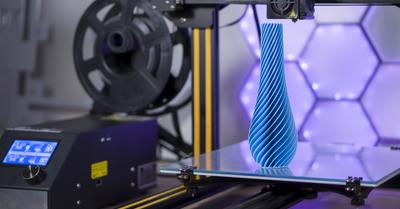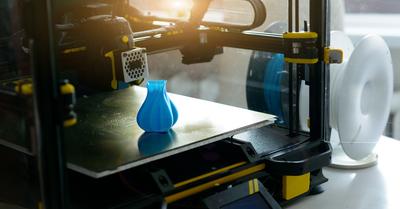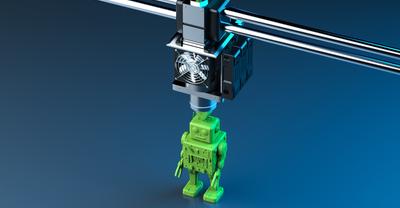What is PETG, and Why is it so Commonly Used?
When you’re designing something new to print, the quality of the material is very important. Using a material that doesn’t have the properties necessary for your project can cause problems, but improper usage can also ruin a print very quickly. Knowing if you need to use an enclosure can help you ensure that your print comes out as it is supposed to.
Understanding the material you’re using to print, along with the effects that different elements can have on your prints, allows you to produce better prints and be more proactive in ensuring that your print quality remains as high as possible. By the time you finish reading, you’ll be an expert in these areas and maybe be able to improve the quality of your PETG prints.
PETG, or polyethylene terephthalate glycol, is a thermoplastic, one of the materials used in FDM 3D printers. Thermoplastics like PETG are used in 3D printers because they are incredibly versatile.
When heated, they can be formed into any shape that the designer desires. As this great material cools, it hardens and maintains the shape it was molded into. This process is also easily repeatable. This means recycled thermoplastics can be melted down and formed into something else without much effort.
PETG has a myriad of properties that make it a favorable choice for all kinds of applications. It is rigid and strong, ensuring resistance to impacts and high pressures.
It's also resistant to harsh chemicals like acids and bases, not to mention that it is both heat and UV-resistant and waterproof. Generally, PETG's remarkable resistance properties make it an excellent choice for crafting items intended for prolonged exposure to various environmental conditions. It maintains its structural integrity even in the most challenging and harsh settings.
PETG is also very affordable, which explains its widespread use in various industries and applications. You'll likely discover PETG-made items throughout your household due to their affordability and versatility.
Another great benefit of PETG is that it is non-toxic and food-safe. This allows it to be used in countless products across the food and beverage industry.
Water and soda bottles are made from it, as well as the plastic take-out containers you get from your favorite restaurant. The recyclability of this material makes it an even better choice for the packaging of many consumable products.
PETG is also used in the medical field for things like medical device packaging and medical implants. As mentioned, PETG has a structure, which means it can withstand all of the chemicals and processes used to sterilize medical instruments.
Its exceptional qualities render it an excellent option for manufacturing medical instruments. Its robustness and resilience in challenging conditions ensure these instruments maintain their structural integrity and durability even after being implanted or used inside the human body.
Does PETG Need an Enclosure When Being Printed?
PETG has become so popular because it’s easy to use, cheap to produce, and doesn’t require much work to maintain. However, PETG can be prone to warping caused by sudden changes in temperature. Because of this, you might not need an enclosure to produce quality prints.
However, you will undoubtedly notice the positive effects of using an enclosure when printing PETG parts.
The main benefit of using an enclosure while printing is that the enclosure maintains a stable environment for your model to be printed in. Enclosures do a better job of maintaining a constant build plate or bed temperature on the printing surface and in the air around the rest of the print.
This makes things like warping and shrinking less likely to occur, and therefore, the quality of your print will be much higher. Additionally, it ensures a smooth surface finish after post-processing activities.
Enclosures also prevent dust and other small particles from entering the printing environment and causing problems with your print. While many individuals don't operate their 3D printers in excessively dirty environments, even tiny particles, such as dust or airborne moisture from various sources, can inadvertently settle on the printed object.
Consequently, these contaminants may disrupt the proper layer adhesion during the printing process. Poor layer adhesion compromises the structural integrity and overall strength of the final print.
Also, printing at a lower layer height may increase the risk of stringing and oozing, especially if the printer lacks precise temperature control. In such cases, an enclosure can help stabilize the printing environment and reduce stringing.
How Can I Ensure That I Produce High-Quality PETG Prints Without an Enclosure?
Even if you decide to go without an enclosure, despite the many benefits, there are certain things you can do to make sure that your PETG prints are of the highest quality possible.
Firstly, you’ll want to ensure that your temperature is set correctly. Temperature is incredibly important for the quality of your prints, so you might need to do a bit of experimentation.
PETG prints the best when the extruder temperature is between 210 and 255 degrees Celsius, but there is room for error in this range. As a general rule, if the print comes out droopy and saggy, the print temperature is set too hot, and if the layers of your print aren’t adhering properly, it's most likely too cold.
Once you know if the printer is too hot or cold, adjust the setting by 5 degrees in the appropriate direction. Doing a few test prints and figuring out the best temperature will ensure that any future prints will be of the best quality possible.
Ambient temperature is also important when it comes to the print bed. Though you don’t need a heated bed to make successful PETG prints, it can help improve the quality of the final product.
Also, the printer’s power supply should meet all the safety standards to prevent electrical hazards. Ideally, the right hot end temperature should be set anywhere from 50 to 75 degrees Celsius.
Note that sudden temperature changes can cause the PETG material to contract or expand rapidly, potentially damaging its own enclosure. This may also affect the temperature inside.
To prevent high temperatures or overheating, set the slicer settings correctly, they adjust the cooling fan to prevent overheating.
Another way to produce quality PETG prints is by ensuring that your PETG filament is dry. One of the few drawbacks to PETG is that it is a hygroscopic material. This means that it actively absorbs water from the air around it.
Storing PETG in a particularly wet or humid environment can cause your PETG to get saturated with water. This will no doubt have a negative effect on the quality of your prints.
To address this, be more careful and proactive in the way you store your PETG. Keeping your PETG in an enclosed container will help prevent water absorption. You can even vacuum your PETG if you want it to be safe.
If you don’t have a vacuum sealer or an appropriately sized container for the job, dehumidifiers and silica gel beads can help suck the moisture out of the air before your PETG has a chance to.
If all these attempts fail, a filament dryer can dry out your PETG to ensure that no extra moisture is left inside upon use.
Also, you can ensure quality prints without an enclosure by using the correct retraction settings. By adjusting parameters like retraction speed and retraction distance, you can reduce the likelihood of stringing between functional parts.









